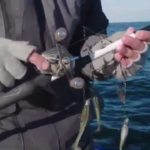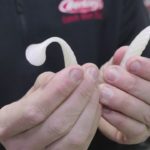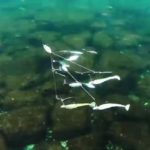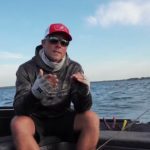Saving the Best for Last
 Just when you thought it was safe to winterize your rig and put it away for the season something comes along and changes things, like the urge to get on the water and give late fall walleyes one more try. It would be easier to write the whole thing off if it wasn’t so darn good and if you were less than a serious walleye angler. Serious anglers simply can’t ignore the tremendous opportunity of working the very last of the late season.
Just when you thought it was safe to winterize your rig and put it away for the season something comes along and changes things, like the urge to get on the water and give late fall walleyes one more try. It would be easier to write the whole thing off if it wasn’t so darn good and if you were less than a serious walleye angler. Serious anglers simply can’t ignore the tremendous opportunity of working the very last of the late season.
The two to three week period before freeze up is what we’re really talking about, and it will be here and gone before you know it. In fact, the best action often occurs when shallower bays are starting to ice over and getting on the lake may become more of a challenge.
Accesses can be frozen in and you may have to be a little creative to get a boat launched. An option is to break up the ice with your boat, if it’s not too thick. If you try backing your boat onto the ice and the trailer doesn’t break through, it’s too thick.
Breaking a little ice for a chance at some late season angling can be well worth the effort, and is a situation to look out for. The period leading up to the last few days can provide plenty of action, but that last of the last can be absolutely phenomenal. For whatever reason, walleyes seem to turn it up a notch or two when the first layers of ice is start to develop.
Ice anglers know that the action surrounding the first ice period can be the hottest of the entire frozen water season, and they wouldn’t miss it for anything. The key to cashing in on the hottest action is getting there before the masses show up with all of their noise and commotion. Too many anglers can spoil the broth, and is a situation to try and avoid. Open water anglers can beat all of them to the punch, by keying on the ” last few days”.
Another advantage of working late is the ability to get dialed in on walleye location which can be a huge advantage at first ice. With a good graph and a GPS like the Garmin GPSMap 178C you can quickly scan over potential hangouts and lock in the high percentage spots. Spots like little underwater points, or hard bottom areas like a little patch of gravel or rock, or even an inside turn in a weed line can be scoped out and entered into the memory of the 178C. That information can then be entered into a handheld unit like the Garmin 60C which can get you back to the exact spot and save you valuable time when you return at first ice.
Spending a little time with you’re eyes glued to the screen of an underwater camera like the Marcum VS560 can be another great idea and will help you identify those areas that have a slight variation which may make them more productive than the rest. The Marcum VS560 has a slick new rotating camera that pans 360 degrees inside of a stationary housing. By dropping the camera to the desired level you can pan back and forth and take in a full view of everything there is to see, like bottom makeup and fish.
Finding late season walleyes can be a snap, especially if you know where to look. Classic late fall walleye location usually includes “classic” structure like fast breaks and hard bottom. Quick break lines near shallower flats area a good bet as well as fast drops along deeper offshore structure. Weed lines don’t really fall into the classic category but they too can be red hot late in the season.
 Weed lines can attract plenty of walleyes, and are often overlooked. Look for the deepest growing green weeds you find, nearest the deepest water available. Good weed line areas to key on are points, inside turns, and rock or gravel spines that extend into the weed flat. Those are the secret high percentage spots that aren’t that easy to find and something you might want to keep to yourself, once located.
Weed lines can attract plenty of walleyes, and are often overlooked. Look for the deepest growing green weeds you find, nearest the deepest water available. Good weed line areas to key on are points, inside turns, and rock or gravel spines that extend into the weed flat. Those are the secret high percentage spots that aren’t that easy to find and something you might want to keep to yourself, once located.
Regardless of where you’re fishing how you do it remains the same. Top late season presentations include live bait rigging and jigging, heavy on the minnows. Minnows like rainbow chubs, fatheads and shiners, are all readily available, and about all you need to put a few chunky late season ‘eyes in the boat. Rainbows and larger shiners work well with a live bait rig, while smaller shiners and fatheads are more suitable for tipping a jig. Red tail chubs are another excellent rigging option, but aren’t always that easy to find.
A variation on the standard lift and drop jigging technique is to replace the jig with a bait usually associated with ice fishing like The Northland Tackle Mini Airplane Jig. When you think about it you’re as close to ice fishing as you’re going to get at this time; So what are the hottest baits at first ice? The answer is jigging spoons and baits like the Northland Airplane Jig.
While the standard technique for late fall jigging is a simple lift and drop of the bait, the Airplane Jig requires more of sweep, and slow fall. This is accomplished by dropping the bait to the bottom, picking it up a few inches or so, and then sweeping it up with about a two foot stroke, followed by allowing the bait to fall on a slack line. As it falls you can see the line pull off the surface. If it stops short of what you think is the bottom, set the hook. If you see it twitch before you think it hit the bottom, again, set the hook.
Whether it’s a jig, rig, or an Airplane Jig, it would be a good idea to work as slowly and thoroughly as you can. Even though late season walleyes can be expected to be on the bite, that doesn’t mean they’ll chase down a bait moving at warp speed. The key is keeping your bait in front of potential customers as long as possible and give them give plenty of time to take the bait. See you on the water, one more time.





